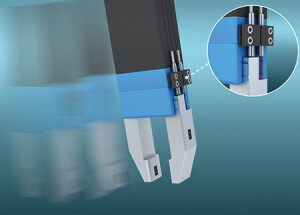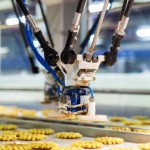Miniature inductive sensors help robots get a grip on fragile silicon wafers
 During automated production of solar cells, compact two-finger grippers transport trays of silicon wafers between operations. To avoid impacts on the wafer’s surfaces, process engineers require reliable confirmation that gripper jaws are fully open before the gripper descends to pick up a tray.
During automated production of solar cells, compact two-finger grippers transport trays of silicon wafers between operations. To avoid impacts on the wafer’s surfaces, process engineers require reliable confirmation that gripper jaws are fully open before the gripper descends to pick up a tray.
Contrinex’s Ultra-miniature inductive proximity sensors, mounted directly above the top faces of the gripper fingers, sense the position of the jaws in the fully open position, eliminating avoidable scrap costs.
Eliminating avoidable scrap costs has to be at the top of any production engineer’s to-do list, particularly when rectifying component damage also means interrupting a fast-moving automated production line. When the component in question is a costly photovoltaic silicon wafer, designers often turn to automated handling systems, although relying on these to achieve perfect alignment isn’t always the answer.
In a manufacturing cell, handling systems assemble solar cells before presenting them for automated testing. To start, trays of silicon wafers are transported between operations by two-finger edge-grippers. If gripper malfunctions occur, scrap costs can mount rapidly, with mechanical damage caused by impacts on the wafer surfaces being a common cause.
Analysis showed that open/close errors account for a significant proportion of gripper malfunctions. Software routines alone can’t identify the position of the gripper fingers; attempts to pick up a wafer tray with the jaws only partially open result in fingers impacting on the wafer surfaces. A cost-effective hardware solution is required to provide overriding inhibition of picking routines if this situation arises.
Customer solution
Designers specified two-finger grippers fitted with Contrinex Ultra-miniature inductive sensors as a reliable and cost-effective means of detecting the position of the jaws at the extremes of travel. Before the gripper descends to pick up a tray, these miniature proximity sensors, mounted directly above the top faces of the gripper fingers, sense the position of the jaws in the fully open position.
Ultraminiature inductive sensors are designed with the needs of OEMs and system integrators in mind and provide an unobtrusive fit-and-forget solution. These miniature devices weigh only 25 grams, and with a compact 3mm-diameter x 22mm V2A stainless-steel housing, they allow easy integration in tight spaces with insufficient room for traditional devices.
With a sensing distance of 1mm, MiniDist devices offer designers attractive alternatives when specifying equipment. Industry-standard PNP and NPN outputs with normally open or normally closed options ensure optimum flexibility when interfacing with a wide range of control systems. Connection is via a PUR-sheathed cable with a 3-pin connector or 2-meter flying lead; alternative lengths are available.
These highly versatile miniature sensors meet designers’ needs for reliable operation while preventing accidental damage. The solution is both highly reliable and cost-effective while eliminating avoidable scrap costs; payback is rapid, while production throughput is maintained at target levels without increasing the cost of quality.
The inclusion of IO-Link, a standardised point-to-point serial connection protocol for sensors and actuators, is provided at no additional cost. It offers the advantages of digital communication without the need for special cabling, making them ideal for Industry 4 applications.
Visit the Plus Automation website for more information
















